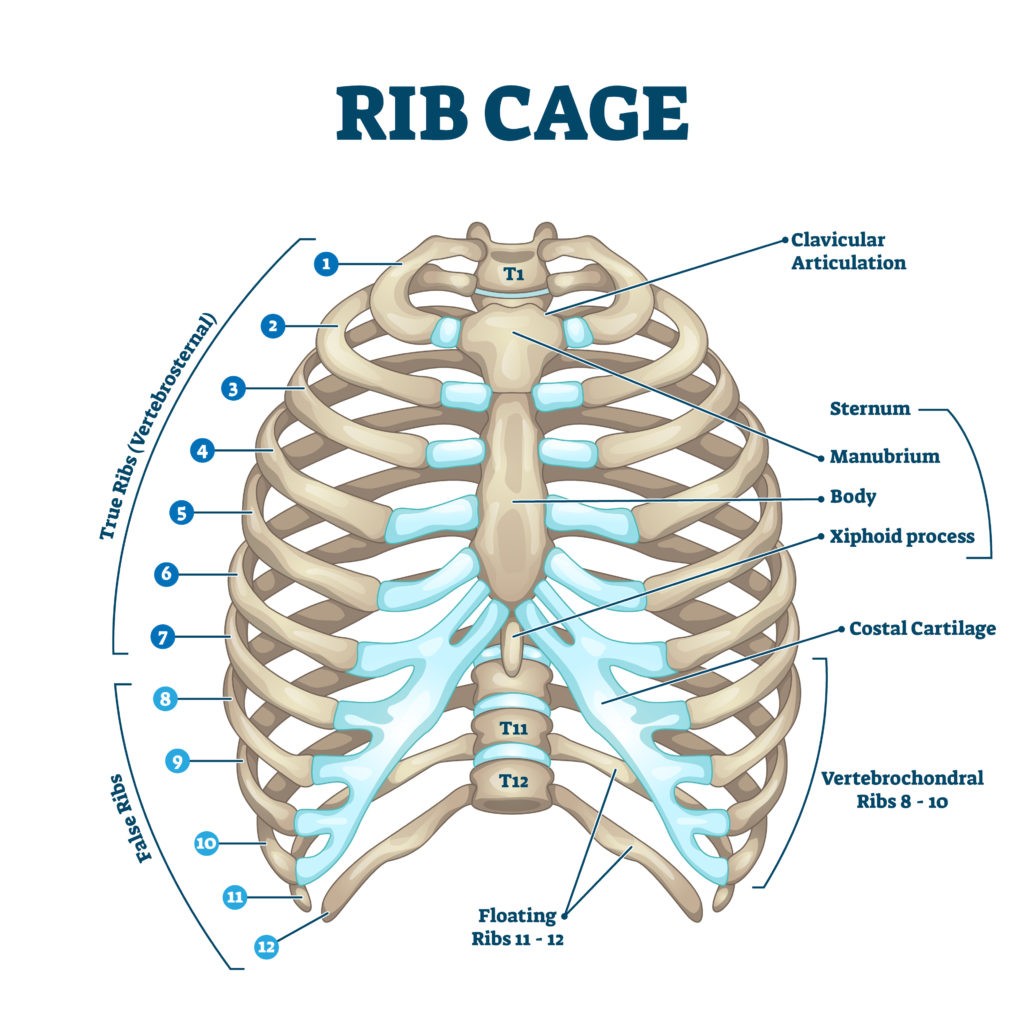VA Disability Ratings for Costochondritis

CCK Law: Our Vital Role in Veterans Law
Many people who experience costochondritis are alarmed, as it is a condition that can mimic symptoms of a heart attack. Continue reading to learn more about VA disability benefits for costochondritis and the rating system used to designate compensation benefits.
What is Costochondritis?
Costochondritis is the inflammation of cartilage surrounding the ribs and sternum, or breastbone. This cartilage can act as a cushion for the joints and absorb any sort of shock to the area. When the cartilage becomes inflamed, a person may experience chest pain that can occur suddenly or happen gradually.
Pain may increase with certain positions, like laying down, or pressure on the chest, which could come from wearing a seat belt or similar activities. Deep breathing and physical activity can also increase pain brought on by costochondritis.
Costochondritis vs. Heart Attack: Knowing the Symptoms
The symptoms of costochondritis can often mimic those of a heart attack, making it difficult to differentiate between the two.
The pain that accompanies a heart attack will typically be more widespread and come with additional symptoms. A heart attack usually causes breathlessness, nausea, and sweating.
If a person experiences sudden onset chest pain, they should contact emergency services right away, as it could possibly be a heart attack. If a person has persistent chest pain, it is important to see a doctor so they can determine if there is an underlying cause.
Costochondritis vs. Tietze Syndrome
Another condition which acts similarly to costochondritis is Tietze syndrome. Tietze syndrome is a rare condition that causes chest pain and swelling of the cartilage that connects the ribs to the sternum. However, costochondritis and Tietze syndrome differ in which ribs are affected.
With Tietze syndrome, the upper four ribs are usually the ones affected. Tietze syndrome can also cause chest swelling that may occur in the cartilage of one or multiple of these ribs. The swelling may appear as a bump in the chest.
As for costochondritis, the pain can sometimes be more widespread throughout the ribcage. Costochondritis is usually more common in those over 40, while Tietze syndrome is more common in younger people.
Causes of Costochondritis
Inflammation occurs as the body responds to injuries, infections, or irritation in general. Below are some common instances from which costochondritis may occur:
- After a severe coughing fit
- As a result of chest injury
- By physical strain from repetitive exercises or overexertion
- With an infection such as a respiratory tract infection or an infected wound
- Prolonged wear and tear
Diagnosis
A doctor should be able to help diagnose costochondritis. This will probably involve a medical examination, particularly of the upper chest area. A doctor may also ask about recent medical history to help determine what may be causing the chest pain.
Additional testing to diagnose costochondritis may include:
- Blood tests
- X-rays
- An electrocardiogram, or ECG
Treatment
There are various forms of treatment which may be used to ease the symptoms of costochondritis. The goal will typically be to reduce the inflammation, which in turn should decrease the amount of chest pain. Types of treatment may include:
- Medication, such as painkillers
- Corticosteroid injections
- Transcutaneous electrical nerve stimulation (TENS)
VA Service Connection for Costochondritis
In order to become service-connected for costochondritis, the veteran will typically need to prove three things to VA. The veteran will need to have:
- An in-service event, injury, or illness;
- A current diagnosis by a medical professional; and
- A medical nexus, or link, between your in-service event, injury, or illness and your current diagnosis.
The veteran can submit their claim on VA Form 21-526EZ. This can be submitted via mail to the Evidence Intake Center or electronically through VA’s website.
There are many ways costochondritis may be linked to a veteran’s service. If a veteran experiences a chest injury during their service, they may have developed costochondritis. The intense physicality of service and the repetition of exercises, like those demanded of many servicemembers during boot camp, can also cause costochondritis.

Presumptive VA Service Connection
Exposure to burn pits caused a host of respiratory problems for veterans who served during the post-9/11 era. Side effects of exposure can range from short term ailments to long term conditions. As burn pit exposure can affect lung health, coughing is often a symptom of exposure. Excessive coughing can cause swelling in the chest, or costochondritis.
With some forms of exposure, such as Agent Orange exposure, VA offers presumptive service connection. Presumptive service connection essentially means that VA recognizes some conditions were caused by their military service, or specifically exposure during their military service. Presumptive service connection places less of the burden of proof on the veteran, making it easier for veterans to receive VA disability benefits.
While exposure to burn pits, and specifically the smoke from burn pits, has caused adverse health conditions, VA does not currently have presumptive service connection for burn pit exposure. However, VA recently announced that it will begin adjudicating disability claims for asthma, rhinitis, and sinusitis on a presumptive basis based on presumed particulate matter exposures. Veterans with these conditions may qualify for presumptive service connection if they:
- Served in the Southwest Asia theater of operations beginning Aug. 2, 1990, to the present, or
- Served in Afghanistan, Uzbekistan, Syria or Djibouti beginning Sept. 19, 2001, to the present
Secondary Service Connection
Another popular path to service connection is through secondary service connection. Secondary service connection can occur if a veteran’s already service-connected disability causes or aggravates a non-service-connected disability. Disabilities that are service-connected on a secondary basis are rated the same way as other service-connected disabilities.
As costochondritis can occur as the result of excessive coughing, veterans with service-connected conditions that cause a recurring cough may be able to become secondary service-connected for their costochondritis. For example, a veteran who is service-connected for chronic obstructive pulmonary disease, or COPD, could become service-connected for costochondritis as secondary to COPD.
Compensation and Pension (C&P) Exams for Costochondritis
Veterans who file a claim for costochondritis may find that VA eventually requests a compensation and pension (C&P) exam. A C&P exam is typically a physical evaluation that is performed by a VA examiner or a VA contracted examiner. During the exam, an examiner may physically examine the veteran, ask questions about the veteran’s service, or aim to understand the connection between the veteran’s costochondritis and their service.
The examiner should be knowledgeable about the information in a veteran’s c-file. A c-file contains any documentation that VA has regarding previously submitted claims, as well as the veteran’s medical and service records.
Veterans may also use a DBQ, or Disability Benefits Questionnaire, to help support their claim. This is a specific form created by VA with the aim of giving veterans a chance to address important aspects of their condition, such as symptoms, severity, and potential causes. The veteran may also speak to the relationship between their condition and other conditions. With costochondritis, a DBQ may be used to indicate the relationship between a condition like COPD and costochondritis. A private doctor that treats the veteran outside of a VA medical center can also fill out a DBQ.
The most important thing about C&P exams is attendance. If you fail to attend a C&P exam, VA may deny your claim. When VA schedules you for a C&P exam, it may call the phone number they have on file or send a letter to your address. It is critical that veterans ensure VA has the most up-to-date contact information so that they do not miss any C&P exam requests. If you did miss a C&P exam, you should contact VA as soon as possible to see if you can reschedule.
VA Disability Ratings for Costochondritis
Costochondritis does not have a specific diagnostic code for VA ratings. Essentially, this means that it can be rated analogously to the part of the body that is affected.
For example, costochondritis is commonly rated under 38 C.F.R. § 4.73, Diagnostic Group 5321. This diagnostic code is used for Group XXI, meaning the muscles of respiration or thoracic muscle group. The ratings for this group are as follows:
- 20%–This rating is given to veterans who experience “severe” or “moderately severe” impediment on the function of any of the muscles in the thoracic muscle group.
- 10%–A 10 percent rating is given to veterans with “moderate” impact on the function of their respiratory muscles.
- 0%–The 0 percent rating is given to veterans when they experience “slight” impact on their respiratory muscles.

VA Individual Unemployability (TDIU) and Costochondritis
Although the rating system for costochondritis can be confusing and is often limited to 20 percent under diagnostic code 5321, they can help boost a veteran’s overall combined rating. This can be particularly useful for veterans looking to achieve the schedular criteria for TDIU.
TDIU, or total disability based on individual unemployability, is a monthly VA disability benefit that compensates veterans who are prevented from working because of their condition(s) at the 100 percent rating level, even if their disability rating may be less than that.
For schedular TDIU, veterans must meet the criteria listed under 38 CFR § 4.16a. The criteria stipulate that veterans must have one condition rated at 60 percent minimum OR two conditions that can be combined to reach 70 percent, where one condition is at a minimum of 40 percent. Here the ratings for costochondritis may help boost a veteran to the 70 percent combined rating, so long as they have at least one condition rated at 40 percent.
Veterans who do not meet these qualifications may be eligible for extra-schedular TDIU. For this form of TDIU, veterans must prove that their condition(s) uniquely hinders their ability to maintain substantially gainful employment. Extra-schedular TDIU is rated under 38 CFR § 4.16b.
Get the Help You Need for a Costochondritis VA Disability Appeal
A number of factors make obtaining VA benefits for costochondritis a difficult, confusing process. Costochondritis does not have its own diagnostic code, which can bring complications with vague rating criteria. Additionally, costochondritis may be brought on as a complication from burn pit exposure. Veterans must prove a connection between their costochondritis and burn pit exposure to receive compensation.
The above complications can lead many veterans to feel as though claims for costochondritis are unwinnable. If your claim for costochondritis has been previously denied, it does not mean you need to give up hope. The experienced team at Chisholm Chisholm & Kilpatrick has had proven success fighting appeals for costochondritis benefits. Additionally, our team has helped veterans secure increased ratings for costochondritis with their appeals.
If you need help with your appeal for costochondritis disability benefits, we may be able to assist you. Call our office for a free case evaluation today at 800-544-9144.
About the Author
Share this Post


